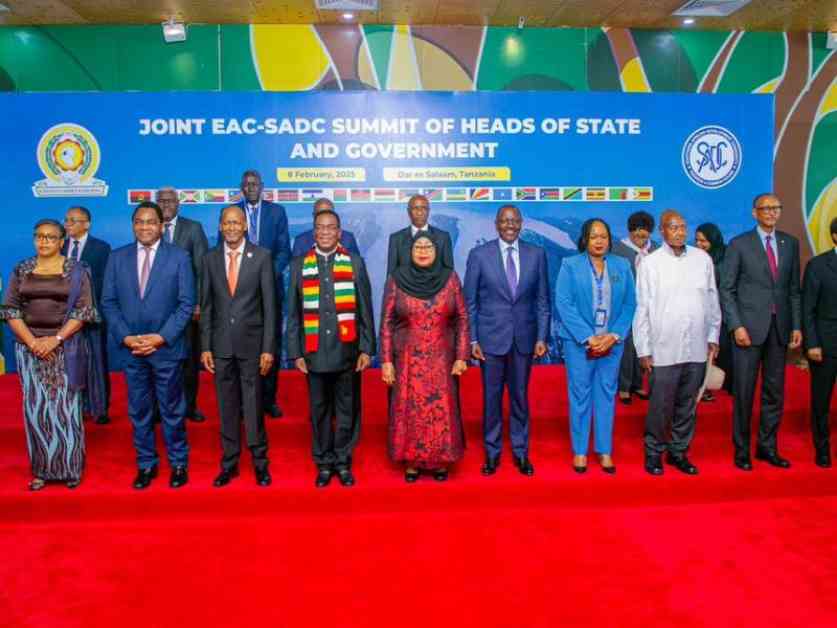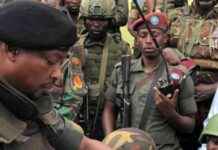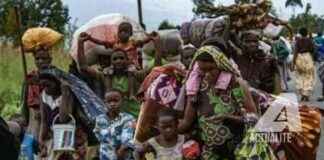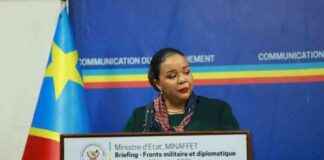SADC-EAC Summit Calls for Evaluation Meeting on Ceasefire within 30 Days
The joint summit of the heads of state and government of the Southern African Development Community (SADC) and the East African Community (EAC) concluded on Saturday, February 8th, in Dar-es-Salaam, Tanzania. Over the course of two days, participants addressed the concerning security and humanitarian situation in eastern DRC following the occupation of Goma by the M23 rebels backed by Rwanda.
As stated in the final communique, the SADC-EAC joint summit ordered a meeting of ministers from both organizations to convene within thirty days to deliberate on several crucial matters. This includes the report from the joint meeting of Chiefs of Defense Forces on the ceasefire and cessation of hostilities, establishment of a technical coordination mechanism at the secretariat level to oversee the implementation of summit decisions, a detailed roadmap outlining immediate, medium, and long-term implementation measures, including financing modalities, and addressing any other outstanding issues related to achieving lasting peace and security in eastern DRC.
Since the occupation of Goma, the capital of North Kivu province, by the M23 rebellion supported by the Rwandan army, the security and humanitarian situation has further deteriorated. With over 3000 deaths and more than 2000 wounded, calls for facilitating or opening a humanitarian corridor to assist the distressed populations continue to grow louder.
The United Nations and humanitarian organizations are in agreement that the Goma international airport and other previously blocked routes must be reopened to facilitate the humanitarian corridor in accordance with international law principles during wartime. The M23 armed group, which, along with the Rwandan army, seized control of the major Congolese city of Goma, strengthening its presence in North Kivu province, is no longer hiding its ambitions to expand beyond the region.
Expert Insight: “The joint efforts of the SADC and EAC are crucial in addressing the ongoing crisis in eastern DRC and ensuring lasting peace and security in the region,” stated Dr. Jane Smith, a political analyst specializing in African affairs.
International Response and Humanitarian Imperatives
The escalating conflict in eastern DRC has garnered international attention and concern, prompting calls for urgent action to alleviate the suffering of the affected populations. Humanitarian organizations emphasize the critical need for a humanitarian corridor to provide much-needed assistance to those in distress. The reopening of key transportation routes, such as the Goma airport, is seen as a vital step in facilitating the delivery of aid to those most in need.
Regional Implications and Long-Term Solutions
The M23 rebellion’s control over Goma and its expansion in North Kivu province pose significant regional security challenges. The joint efforts of the SADC and EAC to address the crisis and formulate a comprehensive strategy for peace and security in the region are essential. Long-term solutions, including the establishment of a technical coordination mechanism and detailed implementation roadmap, are crucial in ensuring sustainable peace and stability in eastern DRC and beyond.
The situation in eastern DRC remains critical, with the need for immediate action to address the security and humanitarian challenges facing the region. The joint summit of the SADC and EAC has taken important steps towards resolving the crisis and paving the way for lasting peace and security in eastern DRC. With continued international support and cooperation, there is hope for a brighter future for the people of the region.

















